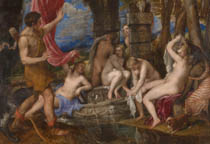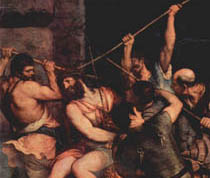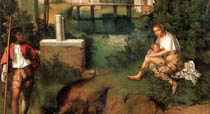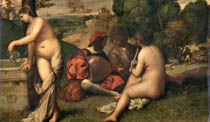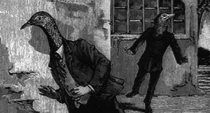| About | Issues | Poetry | Essays | Submit | Order |

The Tempest Concert Champêtre from Une semaine de bonté
|
|||
Before leaving the High Renaissance I want to consider the way the term 'poetry' is used in the visual art of the time. I mean Titian's use of the term poesie, to refer to paintings with mythological subjects, such as the Diana and Actaeon in the National Gallery that he painted for Philip II of Spain in the 1550s. That simple equation might lead us to assume that work dealing with classical mythology should be regarded as a form of visual poetry to differentiate it from subjects dealing with conventional religious imagery that presumably have a more didactic function. Diana and Actaeon refers to one kind of text, the Crowning with Thorns to another. The suggestion is that didactic work — that is to say, work with a didactic text — is not poesie, but classical mythology, work with a less officially authoritative or fixed text, with less dogmatic value. That seems to be Titian's understanding. Looser text offers more opportunity for sensuousness, even voluptuousness, that whole hazy but intense region of feeling where shadows and rich colour are more eloquent than clear formulations. Classical mythology is not a body of clear ideas and precepts for the artist of the Renaissance: it is an occasion in which human beings may indulge themselves by recognizing their longings. Yes, but there is also the poesie of Giorgione, Titian's fellow student in the studio of Giovanni Bellini. Giorgione dies in 1510, long before Titian paints his pictures for Philip II and certainly before Veronese painted his offending painting. Bellini himself was moving from the harder-edged Florentine style paintings to a softer, more atmospheric style rich in colour. Giorgione and Titian took this soft style a step further so that we may now, a little crudely perhaps, think of the Venetian School as sensuous and poetic, as opposed to the intellectual and architectural School of Florence. What Giorgione does is something different: his relation to text is vestigial, fragmentary, imprecise, almost, but not wholly independent. Giorgione's two best known paintings (if they are by Giorgione), The Tempest and Concert Champêtre, are generally referred to as poesie but it would be hard to discern a clear classical mythology in either. And here we approach the nub of the matter. The relation of the sister arts is imprecise, with considerable license on both sides. It is hard to pin it down in terms of property law. We do not consider Veronese to be a rapist of text, though in Mitchell's terms we should do. Titian invites erotic feeling by not relying on specific text. He pays homage to text but establishes a territory between texts, including a text whose codes involve aspects of desire, power and gender relations as understood by his patrons and, it seems, fully assimilated and felt by him. Giorgione's offer of text is in terms of mystery and flirtation. His female figures in their settings refer us to visual language as much as to written text. The connection is almost broken. Interestingly enough there are few poems, as far as I know, about Giorgione's works. We can if we like construct a text to predicate an unknown, undiscovered Giorgione — the weather shall be thus, the disposition of the figures thus, the degree of display thus, the distance from text thus, but we know the poetry is in them already. The fact is that, right through Romantic art and into the late nineteenth century, visual art has taken subjects from written textual sources, whether that is poetry or plays or mythology, or history. It is only at the beginning of the twentieth century, with Modernism, that the idea of a literary subject is questioned, though even then, in Surrealism there is the implication of events as text close to written language — one has only to think of Max Ernst's Une Semaine de Bonté to see how close narrative, albeit disjunctive narrative, is to the production of image. And poets have continued, ever more busily to write about visual art, whether that is in terms of painting, sculpture, photograph, cinema, or indeed conceptual art in ways that might not be described as appropriation, more as conversation, a fascinating game of ideas where the mind gallops off in several directions at once, to find itself gamboling in its own ambiguous fields. * I began with music and would now like to draw these threads together. Speaking as someone who has spent decades writing poems inspired by visual images and patterning them into a kind of form or stillness — in other words one of Mitchell's rapists — I am forced to question the whole issue of poetry and ekphrastics, in which there is an assumption that the aim of a poem is to conjure and speak for the picture, or in some way to appropriate its qualities and make off with them. Is that what happens between the arts? |
|||
from Number 1, June 2012 >> Table of Contents |
|||

